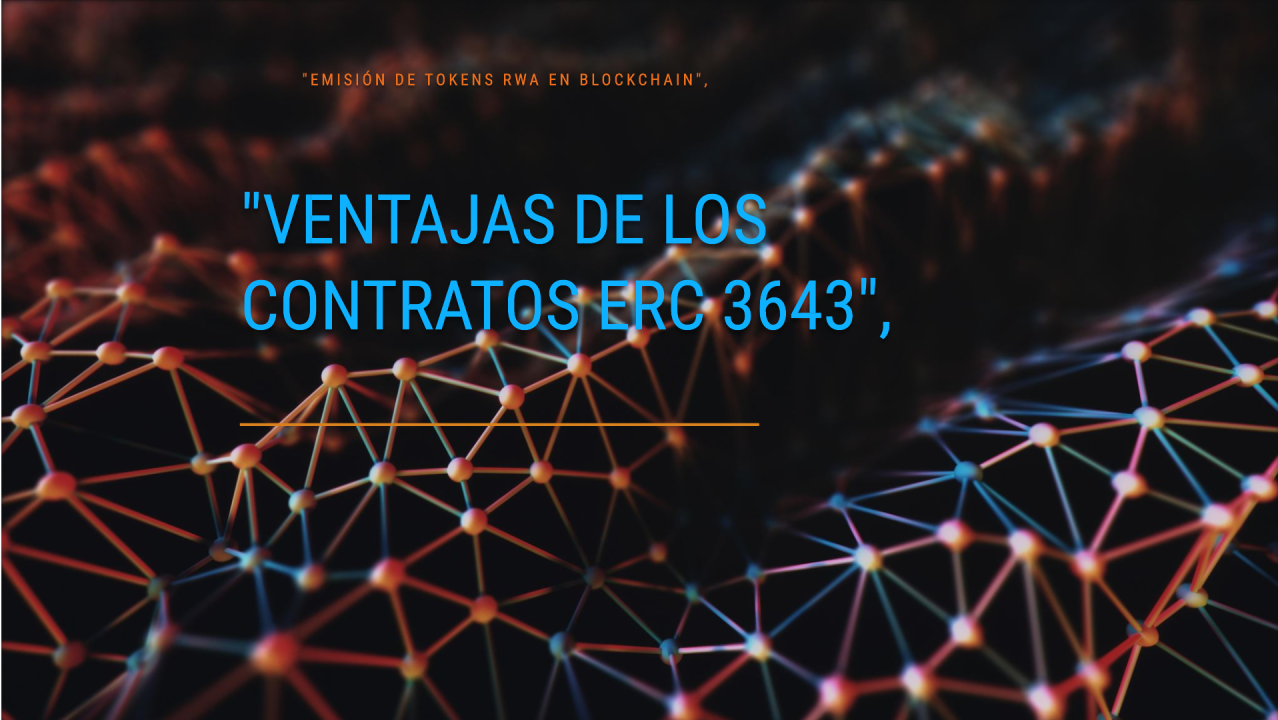| HORACIO LAMPE

Introduction
Blockchain technology has opened up new possibilities for the tokenization of real-world assets (RWA), allowing their digital representation on the blockchain. This process offers numerous advantages, such as fractional ownership, increased liquidity, and reduced intermediaries. However, RWA tokenization also presents challenges, particularly in terms of regulatory compliance. In this context, the ERC-3643 token standard emerges as an innovative solution that addresses the limitations of the widely used ERC-20 standard for issuing fungible tokens.
This report analyzes the advantages of using ERC-3643 contracts compared to ERC-20 for issuing RWA tokens. To achieve this, the characteristics of both standards will be examined, their functionalities compared, and examples of projects using ERC-3643 explored. Additionally, a brief description of the research methodology used for this report will be included.
What are ERC-20 tokens?
The ERC-20 standard is a set of rules defining how fungible tokens are created and managed on the Ethereum blockchain. These tokens are interchangeable, like fiat currencies, and are used to represent various digital assets such as cryptocurrencies, utility tokens, and governance tokens.
Some key features of ERC-20 tokens include:
- Fungibility: Each token is identical to another within the same set.
- Transferability: Tokens can be transferred between Ethereum addresses.
- Approval: Users can authorize third parties to spend their tokens.
- Total supply: The total number of tokens to be issued is defined.
The ERC-20 standard has been fundamental to the growth of the Ethereum ecosystem, enabling the creation of thousands of different tokens. In fact, it is the most popular standard for creating cryptocurrencies in dedicated smart contracts. However, its limitations in regulatory compliance make it unsuitable for RWA tokenization, which is often subject to specific regulations.
What are ERC-3643 tokens?
The ERC-3643 standard, also known as T-REX (Token for Regulated Exchanges), is an extension of ERC-20 designed for the tokenization of regulated assets. Unlike ERC-20, ERC-3643 incorporates compliance functionalities that enable the creation of tokens adhering to securities laws and other regulations.
Key features of ERC-3643 include:
- Permissioned tokens: Only users meeting certain criteria can hold and transfer tokens.
- Conditional transfer functions: Token transfers can be restricted based on predefined rules.
- Digital identity: Digital identity is used to verify user identities and ensure compliance.
- On-chain compliance: Compliance validation occurs directly on the blockchain, enhancing transparency and security. This means that compliance rules are integrated directly into the token, allowing the blockchain to automatically verify whether transaction conditions are met.
Advantages of ERC-3643 for RWA token issuance
ERC-3643 offers significant advantages over ERC-20 for RWA token issuance:
- Regulatory compliance: ERC-3643 allows the creation of tokens that comply with regulations, facilitating the tokenization of assets such as securities, real estate, and debt.
- Enhanced security: Identity verification and conditional transfers increase transaction security and reduce fraud risk. Additionally, by requiring identification for all transacting accounts, ERC-3643 enables the blockchain to serve as a verifiable ledger, enhancing security compared to ERC-20.
- Transparency: On-chain compliance provides an auditable record of all transactions, increasing transparency and trust.
- Interoperability: ERC-3643 is compatible with existing ERC-20-based infrastructure, facilitating integration with DeFi applications and platforms.
- Fractional ownership and secondary markets: ERC-3643 enables the creation of tokens representing fractional ownership of RWA, making investment in previously inaccessible assets easier for smaller investors. Additionally, it fosters the development of secondary markets for these tokens, increasing liquidity.
- Lifecycle management of securities: ERC-3643 provides over 120 functions to control and automate post-issuance operations, such as token locking or recovery. This allows issuers to comply with regulatory obligations and efficiently manage the lifecycle of securities.
- Greater trust for institutional investors: ERC-3643 enables the application of predefined rules for asset usage and governance rights, increasing confidence and transparency for institutional investors.
- Standardization: ERC-3643 addresses standardization challenges that previously hindered the entry of RWA into the blockchain space, facilitating broader adoption.
Examples of projects using ERC-3643
- Metro Futuro: DApps Factory has developed a platform for buying and selling real estate-linked tokens using ERC-3643.
- Pivot: DApps Factory has developed a platform for buying and selling real estate-linked tokens using ERC-3643.
- Aspen Digital Inc.: Tokenized ownership of the St. Regis Aspen Resort in Colorado.
- Mazer Gaming: Tokenized its gaming software and intellectual property.
- Lithium Royalty Corp.: Tokenized its royalties in lithium mining projects.
- ERC3643 Onchain Factory: This tool allows issuers to efficiently deploy and configure ERC-3643 tokens in a single transaction, simplifying the issuance process.
Conclusion
The ERC-3643 standard represents a significant advancement in RWA tokenization, offering greater security, transparency, and regulatory compliance compared to ERC-20. While its implementation is more complex and may involve higher costs, the advantages it provides make it an attractive option for projects seeking to tokenize regulated assets.
ERC-3643's ability to integrate regulatory compliance into the token's structure, along with its advanced identity management and conditional transfer functionalities, positions it as a key standard for driving the adoption of RWA tokenization. By facilitating fractional investment and the development of secondary markets, ERC-3643 opens new possibilities for investment democratization and a more efficient and inclusive financial ecosystem.
As RWA tokenization continues to grow and regulations become stricter, ERC-3643 is likely to become the dominant standard for issuing tokens representing real-world assets. Its ability to address the specific needs of RWA, such as securities lifecycle management and ownership assurance, makes it a fundamental tool for the future of decentralized finance.